Parsing PHP8 underlying kernel source code - array (3)
This article introduces to you "Analysis of PHP8 underlying kernel source code - array (3)". It has certain reference value. Friends in need can refer to it. I hope it will be helpful to everyone.
Recommended related articles: "Analysis of PHP8 underlying kernel source code - array (1) " "Analysis of PHP8 underlying kernel source code - array (2) " Analysis of PHP8 underlying kernel source code - array (4) 》
The above has fully analyzed the basic structure implementation of arrays in PHP and the composition principle of indexes
Relying on the two structures _Bucket and _zend_array
The complexity of o(1) is realized through the hash function
But there is an index array before the bucket. I was understanding this index array at the time I walked through a lot of pitfalls
The picture below is $c =array('x'=>1,'y'=>2,'z'=>3,'a '=>0); The bucket structure of array c

If it is packed, the key is directly nullThere is no need to calculate the hash value. This index array is only used to quickly locate the h value
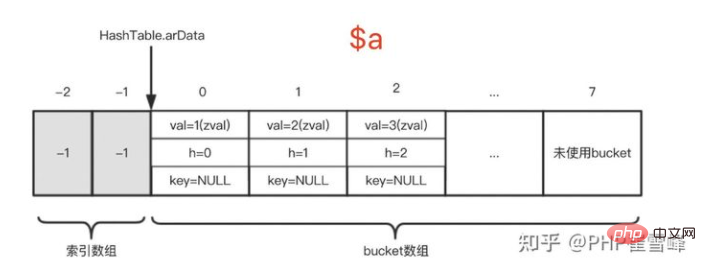 $a =array(1,2,3) bucket
$a =array(1,2,3) buckettypedef struct _Bucket {
zval val; //数组的值 ( 复习下 zval只有16个字节)
zend_ulong h; // key的 h 值
zend_string *key; //当数组为 hash_array时候 会用到 也就是 key的值
} Bucket;array Don't let val affect your learning ideas at this time. The h value is equal to the subscript of the position of the array (arrays all start from 0, so the subscript also starts from 0). For example, $b =array(1=>'a',3=>'b',5=>'c'); mentioned above, where array b is also packed_array and has the following structure

The structure is as follows

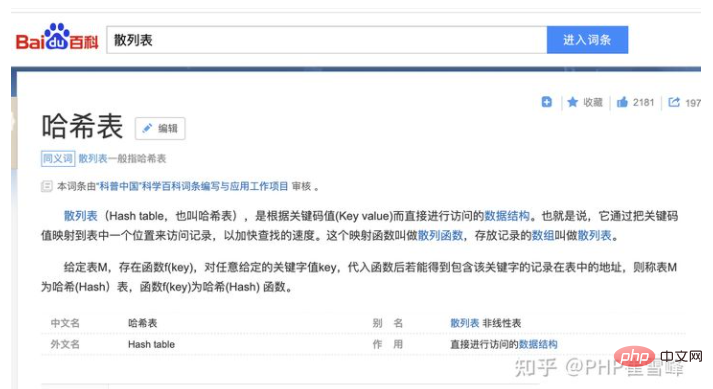
Hash table mainly consists of two parts: storage element array and hash function. A simple hash function can use the remainder method. For example, if the size of the hash table is 8, then when the hash table initializes the array, allocate a space of 8 elements. Follow up the hash code of the key and divide it by 8. The value obtained is this The index of the element in the array. In this way, the key can be mapped to the specific location in the storage array
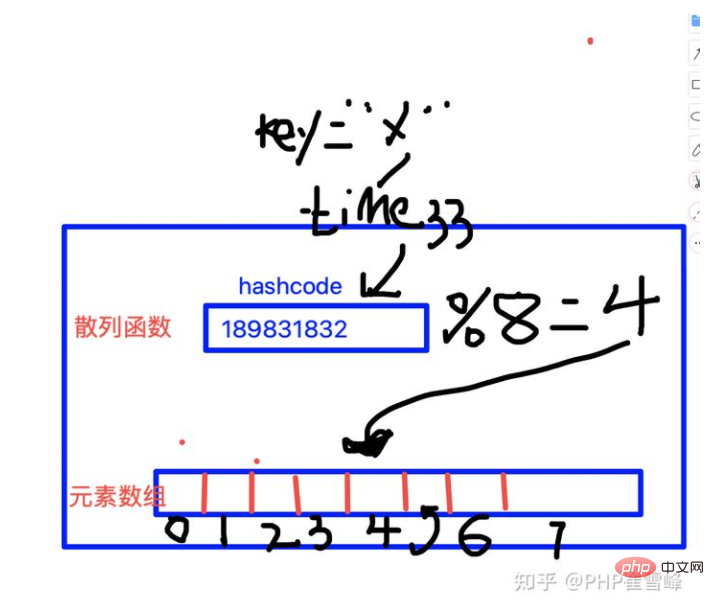
But there is a problem in directly implementing the array in the above way: The position of the elements in the array is random and it is unordered
The array in PHP is ordered, so it adds an index table between the hash function and the element array. This index table is also an array. . The size is the same as the array in which the elements are stored. However, the element type it stores is always an integer, which is used to save the subscript of the element array in the actual stored array: the elements are inserted into the actual stored array in order, and then the array subscript is calculated according to the hash function. The position is stored in the newly added index.
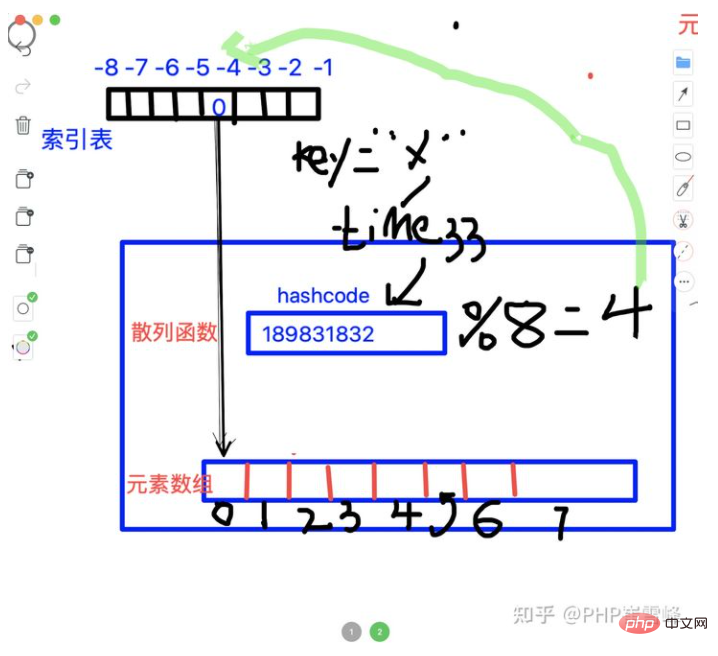
The first step is to calculate 4 and then find -4 in the index table. Because this is the 0th array, put it in the index table The value in the -4th array is set to 0, and then the 0th element in the real array table is set to the real assigned zval
key of different elements in the hash table. The final hash value calculated may be The same thing is that a hash conflict will occur when pointing to a subscript in the same index table. Because the index table can only store one element, PHP uses the zipper method to achieve hash conflict, which is to pull up the value in a linked list. You can refer to the picture below "PHP7 Kernel Analysis - Qin Peng"
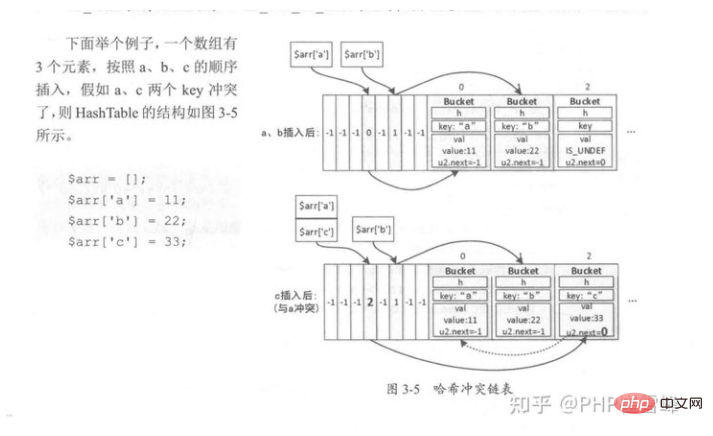
▏This article was published on the PHP Chinese website with the consent of the original author PHP Cui Xuefeng. The original address: https://zhuanlan.zhihu.com/p/360952022
The above is the detailed content of Parsing PHP8 underlying kernel source code - array (3). For more information, please follow other related articles on the PHP Chinese website!

Hot AI Tools

Undresser.AI Undress
AI-powered app for creating realistic nude photos

AI Clothes Remover
Online AI tool for removing clothes from photos.

Undress AI Tool
Undress images for free

Clothoff.io
AI clothes remover

AI Hentai Generator
Generate AI Hentai for free.

Hot Article

Hot Tools

Notepad++7.3.1
Easy-to-use and free code editor

SublimeText3 Chinese version
Chinese version, very easy to use

Zend Studio 13.0.1
Powerful PHP integrated development environment

Dreamweaver CS6
Visual web development tools

SublimeText3 Mac version
God-level code editing software (SublimeText3)

Hot Topics
 How to remove duplicate elements from PHP array using foreach loop?
Apr 27, 2024 am 11:33 AM
How to remove duplicate elements from PHP array using foreach loop?
Apr 27, 2024 am 11:33 AM
The method of using a foreach loop to remove duplicate elements from a PHP array is as follows: traverse the array, and if the element already exists and the current position is not the first occurrence, delete it. For example, if there are duplicate records in the database query results, you can use this method to remove them and obtain results without duplicate records.
 PHP array key value flipping: Comparative performance analysis of different methods
May 03, 2024 pm 09:03 PM
PHP array key value flipping: Comparative performance analysis of different methods
May 03, 2024 pm 09:03 PM
The performance comparison of PHP array key value flipping methods shows that the array_flip() function performs better than the for loop in large arrays (more than 1 million elements) and takes less time. The for loop method of manually flipping key values takes a relatively long time.
 The Art of PHP Array Deep Copy: Using Different Methods to Achieve a Perfect Copy
May 01, 2024 pm 12:30 PM
The Art of PHP Array Deep Copy: Using Different Methods to Achieve a Perfect Copy
May 01, 2024 pm 12:30 PM
Methods for deep copying arrays in PHP include: JSON encoding and decoding using json_decode and json_encode. Use array_map and clone to make deep copies of keys and values. Use serialize and unserialize for serialization and deserialization.
 PHP array multi-dimensional sorting practice: from simple to complex scenarios
Apr 29, 2024 pm 09:12 PM
PHP array multi-dimensional sorting practice: from simple to complex scenarios
Apr 29, 2024 pm 09:12 PM
Multidimensional array sorting can be divided into single column sorting and nested sorting. Single column sorting can use the array_multisort() function to sort by columns; nested sorting requires a recursive function to traverse the array and sort it. Practical cases include sorting by product name and compound sorting by sales volume and price.
 Application of PHP array grouping function in data sorting
May 04, 2024 pm 01:03 PM
Application of PHP array grouping function in data sorting
May 04, 2024 pm 01:03 PM
PHP's array_group_by function can group elements in an array based on keys or closure functions, returning an associative array where the key is the group name and the value is an array of elements belonging to the group.
 Best Practices for Deep Copying PHP Arrays: Discover Efficient Methods
Apr 30, 2024 pm 03:42 PM
Best Practices for Deep Copying PHP Arrays: Discover Efficient Methods
Apr 30, 2024 pm 03:42 PM
The best practice for performing an array deep copy in PHP is to use json_decode(json_encode($arr)) to convert the array to a JSON string and then convert it back to an array. Use unserialize(serialize($arr)) to serialize the array to a string and then deserialize it to a new array. Use the RecursiveIteratorIterator to recursively traverse multidimensional arrays.
 The role of PHP array grouping function in finding duplicate elements
May 05, 2024 am 09:21 AM
The role of PHP array grouping function in finding duplicate elements
May 05, 2024 am 09:21 AM
PHP's array_group() function can be used to group an array by a specified key to find duplicate elements. This function works through the following steps: Use key_callback to specify the grouping key. Optionally use value_callback to determine grouping values. Count grouped elements and identify duplicates. Therefore, the array_group() function is very useful for finding and processing duplicate elements.
 PHP array merging and deduplication algorithm: parallel solution
Apr 18, 2024 pm 02:30 PM
PHP array merging and deduplication algorithm: parallel solution
Apr 18, 2024 pm 02:30 PM
The PHP array merging and deduplication algorithm provides a parallel solution, dividing the original array into small blocks for parallel processing, and the main process merges the results of the blocks to deduplicate. Algorithmic steps: Split the original array into equally allocated small blocks. Process each block for deduplication in parallel. Merge block results and deduplicate again.






